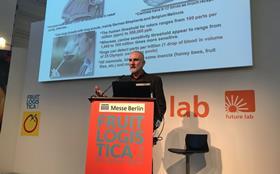
Dogs could hold the key to defeating crop diseases thanks to a revolutionary programme in the United States.
The US Department of Agriculture (USDA) has been working with a canine training and detection company, Coast to Coast K9, to train over 20 dogs to spot plant diseases in fruit orchards. The development was detailed by Professor Dr Tim Gottwald, research leader at the USDA, during a Future Lab session at Fruit Logistica in Berlin, where he estimated the potential savings to the industry as in the “millions”.
Dogs have a sensitivity threshold for odours that ranges from 1,000 to 100 million times more sensitive than humans, and they have been shown to be capable of detecting a single drop of blood in 25 Olympic swimming pools worth of water. Already established as a vital tool in drug and explosives detection, dogs are now being billed as a realistic answer to how to detect disease before they have the chance to wipe out whole orchards.
Extensive trials in the US have shown extraordinary levels of accuracy and speed when using dogs to detect citrus greening (HLB), a devastating disease which is spread by insects and can cause major crop damage for growers.
Large breeds with long snouts, such as German Shepherds and Belgian Malinois, are being used to examine orchards, with the dog trained to sit down whenever it passes a tree infected with HLB. The dog is rewarded with 45 seconds of play time with its handler every time it makes a positive identification.
The trials showed an extraordinary 99.17 per cent accuracy rate when using dogs to identify HLB, versus a detection rate of 50-70 per cent when using molecular techniques. Results are also instant, rather than waiting hours or days for lab testing. Very few false positives or negatives have been recorded.
Perhaps even more remarkably, in a 10,000 tree trial, the dogs were able to detect HLB as soon as the insect had infected it, something that would have been impossible using traditional methods of investigation. Dogs took less than two seconds to investigate each tree and could examine a 10-acre block of trees in 53-103 minutes, depending on the level of disease present.
Gottwald said that, in theory, canine “investigators” could be deployed to hunt down a wide range of plant diseases. Researchers are already trialling the method with liberibacter solanacearum in tomatoes, and a feasibility project is taking place on plum pox. Future projects are expected to focus on Little Cherry Disease and Red Blotch on grapevines.
Gottwald estimated the cost of buying and training a dog as under US$20,000, with a fully-trained dog then able to be sold to a regulatory agency or deployed by canine handlers on a per-acre, per-day or per-week basis. “When you think about the cost of hiring surveyors to do this kind of work, and their low accuracy rate, this is a very accurate and fast alternative,” he concluded. “So it’s very cost effective.”



